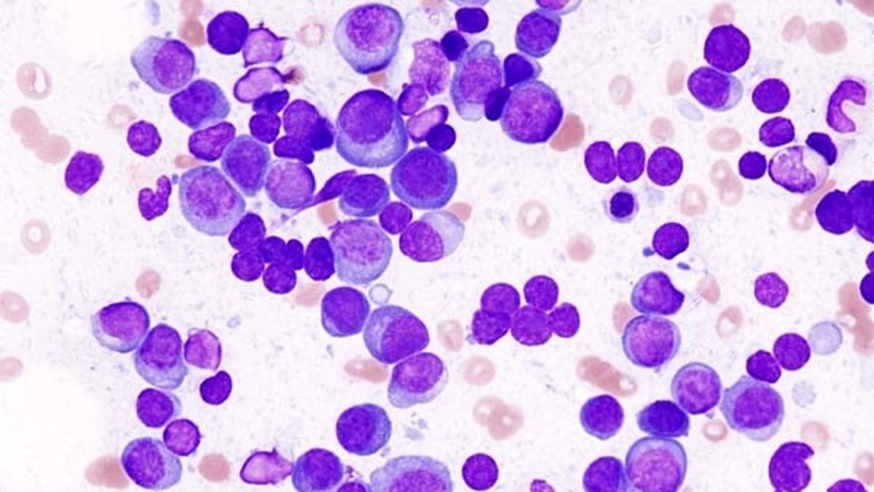
Image: Histopathological image of multiple myeloma. Smear preparation of bone marrow aspirate stained with May-Grünwald-Giemsa procedure. Credit: Wikimedia Commons. Licence: CC-BY-SA 3.0
Assessing DNA for areas of the genome linked to cancer risk could pick out some people with a three-fold increased risk of blood cancer, a new study suggests.
The research identified six new DNA regions linked to a higher risk of multiple myeloma, a cancer of white blood cells made in the bone marrow.
Together with previously identified areas of the genome, their findings explain part of the inherited risk of myeloma. The people classed as at highest risk based on the genetic information identified so far were at three times the risk of developing the disease as the average individual.
Despite there being around 5,700 new cases of myeloma diagnosed in the UK each year, there is still relatively little known about its causes.
This study, which was largely funded by Myeloma UK, increases the understanding of the complex genetics that underpin the disease, and could explain why some individuals are more at risk of developing myeloma.
In future, specific genes in the newly identified risk regions of the DNA could also be possible targets of new drugs to treat the disease.
The research was published in the journal Nature Communications today (13 September 2018).
Research at the ICR is underpinned by generous contributions from our supporters. Find out more about how you can contribute to our mission to make the discoveries to defeat cancer.
Analysed DNA of 10,000 patients
Scientists at The Institute of Cancer Research, London, performed a genetic analysis of myeloma patient samples and gathered data from similar previous studies from around the world, together analysing the DNA of nearly 10,000 people with myeloma.
They found six new regions of the genome that contribute to an increased risk of developing myeloma. Together with the 17 previously identified regions, the new DNA regions explain around 16 per cent of the inherited risk of the disease.
These 23 risk areas in an individual’s genetic information could be inherited by their children, making them more likely to develop myeloma.
People in the highest risk bracket are at threefold higher risk of developing myeloma than the average individual.
The new regions of DNA linked to the risk of developing myeloma were involved in key processes in the cell, such as preparing to divide, avoiding DNA faults and ensuring the DNA is properly folded up.
Further research will be needed to study these areas of the genome in more depth, in order to uncover the specific genes which influence the risk of multiple myeloma.
'Clearer picture of the biology' of myeloma
Dr Simon Ridley, Director of Research at Myeloma UK, said:
Increasing our knowledge of the complex pathways driving the development and progression of myeloma is going to be key to identifying new myeloma therapies, and to enable the tailoring of patient treatments. However, we are not advocating the need for genetic testing for risk of developing myeloma at the moment, as this risk is generally very small indeed, even if a parent has the condition.
Study leader Professor Richard Houlston, Professor of Molecular and Population Genetics at The Institute of Cancer Research, London, said:
“Our study has identified six new areas of the genome that contribute to an increased risk of developing multiple myeloma, a type of blood cancer of which the biological basis has been relatively understudied.
“Our increased understanding of the genetic background of myeloma has allowed us to start forming a clearer picture of the biology of the disease – which could open up new avenues for treatment.”
This study was supported by grants from Myeloma UK, Bloodwise and Cancer Research UK.